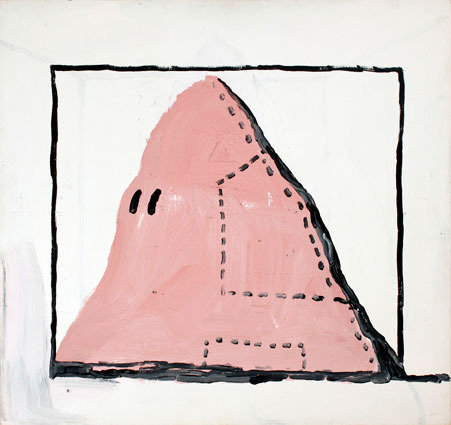Philip Guston
dal 29/4/2014 al 27/6/2014
Segnalato da
29/4/2014
Philip Guston
Aurel Scheibler (new location), Berlin
A group of late drawings and works on canvas complemented by two important earlier paintings. Guston's work also affirms the vitality of painting and its past history in an age glutted with mass media images.

On Wednesday, 30 April, Aurel Scheibler opens his second exhibition devoted to Philip Guston (1913–1980), which comprises of a group of late drawings and works on canvas complemented by two important earlier paintings. Scheibler's first Guston show, organized in 2007 and sourced solely from private collections, was the first Guston exhibition ever to take place in a German gallery. Philip Guston coincides with Philip Guston – Late Works, which takes place at the Sammlung Falckenberg in Hamburg until 25 May and will travel on to the Louisiana Museum of Modern Art in Humlebæk, where it will be on view during the summer. Philip Guston runs until 28 June and will have special opening hours for Gallery Weekend Berlin.
Guston was a major catalyst and his ability to move successfully between figuration and abstraction and back again is particularly relevant today as artists shift regularly between these once mutually exclusive poles. Guston's work also affirms the vitality of painting and its past history in an age glutted with mass media images. The first appearance of his late work in Europe in the influential A New Spirit in Painting exhibition at the Royal Academy in London in 1981 set the tone for a renaissance of the appreciation of painting. Guston's retrospective, which followed in 1982 at the Whitechapel Gallery in London, the Stedelijk Museum in Amsterdam and the Kunsthalle Basel, manifested the important role of the artist for his own generation and many more to come. Today, nobody seriously involved with painting—be it figurative, abstract or both—will be able to circumvent Guston's oeuvre.
Not only is the presentation at Scheibler a complementary chapter to the current museum shows, it also offers the rare opportunity for an intimate engagement with a crucial grouping of Guston's work. The quintessence of the show is formed by a selection of three drawings and seven paintings from what is usually known as his 'late' period. The intriguing feature of this exhibition is the fact that it is corner-stoned by two superb, colorful abstract paintings from 1960 and 1961. These works act as beacons, they clearly open up a way to the obsessive, image-ridden works that Guston will paint from the late sixties onwards as, almost imperceptibly, objective elements gather in lyrical abstraction. They are pivotal works for the understanding of Guston's unique achievements in the story of abstract art.
The three charcoal drawings in the show from 1968 and 1969 are important examples of Guston's new, reduced language, which he developed since 1966. At this point, he had explored abstraction to its limits. He ceased painting altogether, brooding, looking for a fresh start. The way to the tangibility of the late work was pointed out to him through drawing. The most basic of forms, an arc, a banal shape, slowly move into a vocabulary made of unassuming 'things' and objects of everyday life. In 1968 his drawings led to the illustrious hooded "Klan" figures, images that Guston had literally lived with since his teenage years and that had appeared in his early figurative work. The exhibition contains three exemplary paintings from this period in which Guston's renewed confidence and sense of purpose are apparent. In the mid-seventies—four large canvasses of this time are shown—the work takes a new turn. These paintings are naked truths. They mercilessly dissect Guston's troubles and doubts, his inner conflicts and continuous struggles. Although highly charged with self-critical force and a cutting edge, they have the power to let in the light. Guston's lifelong passion for poetry, his endless joy connected to the everyday 'things' whose useful lives take place uncomplainingly alongside his own and his reverence for his wife Musa find their way into this work. The good parts of life exist where its deepest angst and darkest despair loom and Guston had acknowledged and grasped this. He made it visible, tirelessly, in his paintings and drawings. "In my beginning is my end," wrote T.S. Eliot in East Coker. Guston had arrived on the same page.
Movie
A special screening of Philip Guston. A Life Lived, the artist monograph produced by Michael Blackwood Productions Inc. in 1980 will be shown in two movie theaters in Berlin during Gallery Weekend:
Hackesche Höfe Kino, Rosenthaler Straße 40, 10178 Berlin
From 1 through 7 May, daily at 3pm
Exceptional Sunday screening on 4 May at 11am
filmkunst 66, Bleibtreustraße 12, 10623 Berlin
Saturday 3 May at 1:30pm
Catalogue
A catalogue containing illustrations of all exhibited works as well as personal photos from the Guston Estate archives will be published on the occasion of the exhibition. The publication will feature texts by William Corbett, David Schutter and Aurel Scheibler.
Image: Untitled (Hood), 1969. Acrylic on masonite 74,9 x 79,4 cm / 29 1/2 x 31 1/4 in. © The Estate of Philip Guston
Opening Wednesday, 30 April 2014, from 6 p.m. to 9 p.m.
Aurel Scheibler
Schöneberger Ufer 71 10785 Berlin - Tiergarten
Opening hours:
Tuesday - Saturday 11 am - 6 pm
and by appointment.
Friday 2 May: 11am–9pm
Saturday 3 May: 11am–7pm
Sunday 4 May: 11am–7pm



